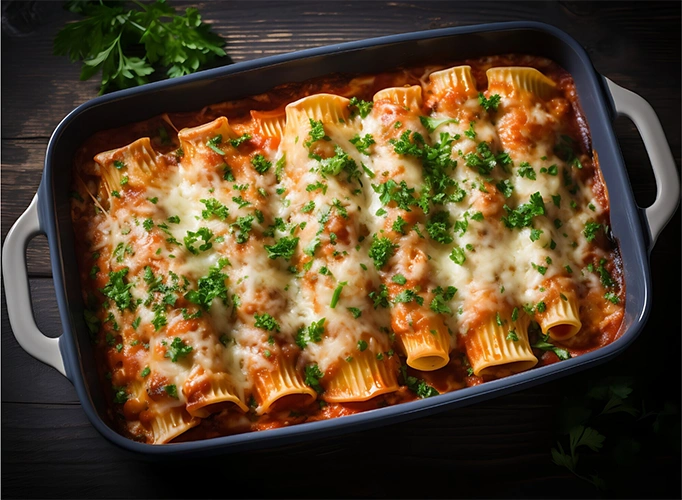

Top Health Benefits of Manicotti You Need to Know
Baked manicotti with cheese and tomato sauce is a hearty and satisfying dish that delivers a balanced mix of macronutrients and essential vitamins. It is particularly rich in calcium and protein due to the generous use of cheeses such as ricotta, mozzarella, and Parmesan, which support bone health and muscle maintenance. The tomato-based sauce provides a source of lycopene, a powerful antioxidant that supports heart health and may help reduce inflammation. Additionally, when spinach is included, the dish becomes a source of iron, folate, and vitamin K. The pasta contributes complex carbohydrates, providing a sustained energy release. While this dish is relatively high in calories and saturated fats, its high nutrient density makes it a comforting, energy-rich option when consumed in moderation as part of a balanced diet.
Recipe :
For 4 people
Enjoy your warm, cheesy, Italian-style baked manicotti with loved ones!
When preparing baked manicotti, careful attention should be paid to a few key details to ensure the best texture and flavor. First, undercook the manicotti shells slightly (al dente), as they will continue to cook while baking in the sauce and filling. Ensure the cheese mixture is well-drained and not too watery, which helps the filling stay firm and flavorful. Using fresh herbs like parsley or basil enhances the taste and aroma without adding extra calories. It's essential to evenly spread a layer of sauce on the baking dish before placing the pasta to prevent sticking and to fully cover the pasta with sauce and cheese to keep it moist and flavorful during baking. Let the dish rest for a few minutes after baking to allow the flavors to settle and the texture to firm up before serving. These small details significantly elevate the final result.

While this dish is vegetarian-friendly and fits well within the Mediterranean and DASH diets when prepared mindfully, it is not suitable for several dietary regimens without significant modifications. It contains gluten, making it unsuitable for gluten-free diets, unless gluten-free pasta is substituted. Due to the high dairy content, it is not appropriate for vegan or paleo diets, and the carbohydrate content from pasta makes it incompatible with ketogenic or low-carb diets. The richness and calorie density also limit its use in low-calorie meal plans or fasting regimens. However, by swapping regular cheese with reduced-fat alternatives and using whole grain or vegetable-based pasta, it can be adapted slightly for higher protein or lower sodium needs. As always, portion control and thoughtful ingredient selection are key to aligning this dish with various health goals.
Xavier (May 20, 2025, 9:08 a.m.) : This Manicotti recipe was classic and comforting—just like a true Italian family dinner! 🇮🇹 The rich, cheesy filling balanced so well with the tangy tomato sauce. I tried adding a bit of nutmeg to the ricotta mixture, which gave it a subtle warmth that paired beautifully with the spinach. Next time I might try a version with béchamel on top for extra creaminess. Perfect for a cozy night in!